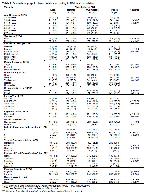The current study was showed that prevalence of overweight and obesity were 34.0% and 31.7% respectively, among adult Turkish population. It has been reported that the prevalence of overweight and obesity is between 15-60% worldwide and is an important public health problem
1. The Studies were reported that 1/3 of the population in the United States of America is overweight and 1/3 is obese
18. In recent studies, the prevalence of overweight and obesity has been reported as 36.5% and 26.5% in China, 64.6% and 30.3% in Russia, 36.2% and 41.7% in Kuwait and 30.1% and 35.6% in Saudi Arabia
19-22, respectively. The current study findings were similar to the current literature data from different countries. The prevalence of overweight and obesity were reported 34.6% and 30.3%, respectively in Turkish community according to Turkey Nutrition and Health research study
23. In the study conducted by Aydın et al., it is reported that prevalence of obesity was 43.5% in the adult Turkish population
24. The current study and other similar studies data were showed that overweight and obesity are high prevalence and a serious health problem among adult population
Considering the current study the prevalence of obesity in women was 40.9% while it was 19.7% in men. The relationship between gender and obesity is contradictory in the literature. In addition to studies reported that higher prevalence of obesity in men 25-27, there were more studies showed that obesity prevalence is higher in women, similar to our findings 19,21,28-31. In studies conducted in Turkey obesity has been reported as higher in women than men, and prevalence of obesity is similar to our findings 2,23,24. Some studies conducted in Turkey have been reported that obesity prevalence is higher in women than in men 2,23,24. In Kuwait and Libya, which have similar cultural and religions properties with Turkey, it is reported that obesity is more common in women 21,31. The reason for the prevalence of obesity among women in these countries has been attributed to the fact that women take less roles in business life and their physical activity opportunities are limited. The reason for the high prevalence of obesity among women in Pakistan has been attributed to early marriage, multigravida and the less role in business life 28. The current study reported that obesity is more common in women and being housewife is a risk factor for obesity. Based on the literature and the current study data we obtained, it was thought that gender and being a housewife are associated with obesity. In the struggle against obesity, we can recommend specific precautions for women and especially housewives.
The most studies in literature were reported that BMI increases with age and obesity prevalence higher in the 50-60 age range 19,20,22,28-31. The current study has found that the obesity prevalence gradually increased with age in both men and women, and aging 45 years and over were an important risk factor for overweight and obesity. The prevalence of overweight and obesity in the 45-75 years of age groups were found to be approximately 10 times higher than the others. The data we obtained were similar to the literature data. The reasons for the increase in the prevalence of obesity with increasing age have been attributed to factors such as reduced physical activity, retirement, working in less demanding jobs, pregnancy and illness. Further studies can focus on the relationship between age and obesity and solutions, so that new methods can be obtained to reduce the prevalence of obesity.
The NCD risk factor collaboration study reported that, obesity which was a problem especially for developed countries in the 1975s, has a higher prevalence rate in countries with low socioeconomic levels in recent years, and nowadays it is an important problem for both developed and developed countries 32. Al-Raddadi et al. were reported that obesity was not associated with household income, but its prevalence increased in men with a high level of education 22. Another study was reported that the risk of obesity increased in those with a low level of education, the unemployed and housewives who do not have any profession 19. Previous literature data could not explain a clear relationship between education level and socioeconomic status and obesity. According to current study, obesity prevalence was higher in illiterate and high income levels. The literature and current study data could not contribute to explaining the relationship between education and income level and obesity. Some studies have been reported that eating habits and physical activity are more important determinants of obesity 19,22,32. The high prevalence of obesity in those with low education and high income in our study data suggests that nutrition and lifestyle may be more important determinants of obesity than socioeconomic factors.
The current study found that the risk of overweight and obesity increased approximately 5.5 times in married people compared to single participants. A meta-analysis study was reported that marriage is associated with weight gain in individuals (33). Most studies in literature have been reported that the prevalence of overweight and obesity are high in married individuals 19,21,28,31. The current study data was found to be compatible with the literature. Especially in Libya, Pakistan and Kuwait, which are similiar religious and cultural structure of Turkey, were found that overweight and obesity are higher in maried individuals. The relationship between marriage and obesity has been associated with early marriage, early pregnancy, multigravida, and changes in physical activity and eating behaviours with marriage 21,28,31. The current study found that obesity prevalence was higher in both married and housewives. It was thought that spending more time at home with marriage and consuming more food during the stay at home can cause obesity. This hypothesis should be considered in future research and the relationship between time spent at home and food consumed with obesity prevalence should be investigated.
It was thought that providing obesity counseling services and informing individuals by family physicians after marriage, especially in routine follow-up to women, may contribute to the fight against obesity.
The current study was found that obesity prevalence is higher in non-smokers than smokers. The relationship between smoking and obesity is contradictory. Liao et al. reported a negative relationship between smoking and obesity in their study 34. Watanabe et al. reported that smoking is a risk factor for obesity 35. In both previous studies on smoking and obesity, were recommend long-term follow-up cohort sudy for to elucidate the limitations of the studies, such as the duration of smoking, the amount of cigarettes smoked daily, and passive smoking, and the relationship between smoking and obesity. Cigarette use is more common in men than women in Turkey. In current study, the fact that women participants were more than men and obesity was higher in women and housewives may have affected the relationship between smoking and obesity. The current study and literature data were insufficient to explain the relationship between smoking and obesity.
In current study, obesity prevalence was found to be statistically higher in participants with hypertension. A previous study has been reported that hypertension is the most common health problem related to obesity, and hypertension is seen twice more frequently in obese patients compared to non-obese 36.
The high prevalence of obesity in hypertensive individuals found in the current study is an expected finding and is consistent with the literature data. In the light of current study and literature data, it can be said that reducing the prevalence of obesity may contribute to the decrease in the prevalence of hypertension in the society.
In conclusion, the current study showed that one third of residents living in Elazig are overweight, and one third are obese, approximately. The obesity prevalence is higher in women and overweight prevalence is higher in men. The prevalence of central obesity was 15.2%. A remarkable finding was that the waist-to-hip ratio in 44.1% of the participants was in the risky category for cardiovascular disease. Factors significantly associated with an increased risk of overweight and obesity were female gender, being married, being a housewife, non-smoker, low education level, high income level and high age. Overweight and obesity is a very important public health problem for Turkish society. In order to protect and improve public health, it may be recommended quickly to take necessary preventions for to reduce overweight and obesity prevelance.
Limitations: The cross-sectional design and short period of the study may have limited the explanation of the relationship between obesity prevalence and causes. Some variables such as diet, income, and physical activity were the participants' own opinions. This situation may cause limitations in explaining the relationship between sociodemographic characteristics and obesity. The another limitation is, the study population was selected as the number of households by sampling method. Selection the study population based on the number of households rather than age and gender distribution may have affected the prevalence of obesity while sampling.
Acknowledgements: We thanks to Elazig provincial health directorate employees.







